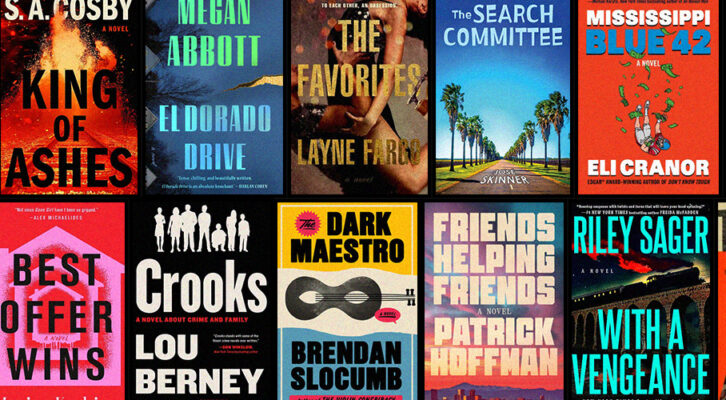
Donald Trump's Sentimental Journey to the Top
Revisiting Joan Didion on 90s NYC, to Make Sense of Present Day America
America has begun to reckon with a nightmarish reality: Donald Trump’s presidential campaign isn’t going anywhere any time soon. I write this dispatch the morning after the primaries in Florida, Illinois, Missouri, North Carolina, and Ohio, in which Trump gained an additional 200-plus delegates, putting his current numbers at 673 delegates to Ted Cruz’s 411 and John Kasich’s 143; the morning after Marco Rubio has “suspended” his campaign; the morning after it has yet again become harder to deny that Trump, in all his vitriol and racism and misogyny, is more than likely to become the Republican option for November.
There have been countless attempts to explain Trump’s enduring hold over the current race. David Remnick’s comment, “American Demagogue,” in the March 14th issue of The New Yorker outlined these potential explanations well: “Some have earnestly ascribed [the Trump phenomenon] to broad social and economic forces, particularly the ‘new normal’ of stagnating wages, underemployment, and corporate ‘offshoring’ and ‘inversion,’” and then added his own: “The Republican Party, having spent years courting the basest impulses in American political culture, now sees the writing on the wall. It reads ‘Donald Trump,’ in very big letters.”
Like Remnick—and like most of my peers, who have been watching in horror as Trump continues to rack up delegates—I haven’t been entirely satisfied with the current answers to why so many Americans are choosing Trump. There can be no simple explanation for why this man, who encourages violence against protesters at his rallies, who refused to decry the support of former Ku Klux Klan Grand Wizard David Duke, who has called for a “total and complete shutdown of Muslims entering the United States,” continues to galvanize support.
And yet I cannot help but try to comprehend Trump’s rise in my own way, and my way of coming to terms with that which is difficult to square has always been to turn to Joan Didion, whose nonfiction works offer not simple explanations but a rejection thereof. Didion has stayed quiet during this campaign cycle, but I found the perspective I was looking for when I turned towards another New York Review of Books piece of hers from the early 1990s, about the Central Park Jogger case: “Sentimental Journeys.”
I made the connection last month, when I read a piece by Oliver Laughland in the Guardian. In the article, Laughland tracks “the racially charged rise of a demagogue”—Donald Trump, of course—bringing us back to New York City in 1989, the scene of the Jogger case, in which five black and Latino male youths, known as the Central Park Five, were (falsely) accused of brutally raping a young white investment banker who was attacked while running through Central Park after dark.
At the time, Trump took out full-page ads in several major New York newspapers with the headline, “BRING BACK THE DEATH PENALTY. BRING BACK OUR POLICE!” The ads began, “What has happened to our City over the past ten years?…What has happened is the complete breakdown of life as we knew it,” hearkening Trump’s current “Make America Great Again” rhetoric, and continued on to such provocative statements as “I want to hate these muggers and murderers. They should be forced to suffer, and when they kill, they should be executed for their crimes.” Laughland quotes civil rights lawyer Michael Warren, who represented the Central Park Five, on the effect of these ads: “He poisoned the minds of many people who lived in New York and who, rightfully, had a natural affinity for the victim.”
Poisoning minds and inciting violence has long been Trump’s M.O., but now that Trump seeks the presidential platform, that M.O. is even more terrifying. Yusef Salaam, one of the Central Park Five (who were acquitted in 2002) spoke to Laughland about Trump’s incitement of public rage in the case and how his rhetoric hasn’t really changed in the past 25 years: “To see that he has not changed his position, of being a hateful person, to see that he has not changed his position of inciting people, to see that he’s still the same person and in many ways he has perfected his sense of being that number-one inciter, you know, I was scared.”
I was especially attuned to news about the Central Park Five when Laughland’s piece came out, because I was preparing to teach Didion’s take on their case, the aforementioned “Sentimental Journeys,” to my first-year writing class at Columbia University. In “Sentimental Journeys,” Didion articulated a vision of the Jogger case that was dangerous to espouse at the time, as, despite physical evidence tying the five teens to the rape and beating, and despite confessions produced under suspect conditions, it would be seen as “a further attack on the victim,” as Didion put it, to suggest that the case deserved “an aggressive defense.”
This is because the case became, in Didion’s eyes, sentimentalized to the point that the victim stood in for everything great about the city and the accused were everything wrong with the city: “In this city rapidly vanishing into the chasm between its actual life and its preferred narratives, what people said when they talked about the case of the Central Park jogger came to seem a kind of poetry… One vision, shared by those who had seized upon the attack on the jogger as an exact representation of what was wrong with the city, was of a city systematically ruined, violated, raped by its underclass… For so long as this case held the city’s febrile attention, then, it offered a narrative for the city’s distress, a frame in which the actual social and economic forces wrenching the city could be personalized and ultimately obscured.”
In other words, it was easier to believe in this crime as representative of the city’s ills than it was to believe in the more complex truth of “real and to a great extent insoluble problems” caused by the fact that “New York works, when it does work, not on a market economy but on the little deals, payoffs, accommodations, baksheesh.” The truth that Didion proposed was that the city was corrupt, that the system was rigged into haves and have-nots, and that this corruption had racial implications.
Didion was writing in the aftermath of the October 1987 stock market crash, when people were coming to terms with a lack of resilience in New York’s economy. “[The] perception that something was ‘wrong,’ in New York had been insidious, a slow-onset illness,” Didion wrote, and New Yorkers were looking to name what was “wrong”; most in the city named it “crime,” as crime seemed a surmountable societal ill. In “Sentimental Journeys,” Didion focuses her sharp yet subtle criticism at a variety of New York actors who drummed up the narrative of “crime”—Governor Mario Cuomo, who called the rape “the ultimate shriek of alarm”; Mayor David Dinkins, who said “I hope this city will be able to learn a lesson from this event”; Chairman and Chief Executive Officer of Salomon Brothers John Gutfreund, who said the victim epitomized “what makes this city so vibrant and so great… struck down by a side of our city that is as awful and terrifying as the creative side is wonderful.” For whatever reason, Didion doesn’t mention Trump and his newspaper ads, but upon re-reading “Sentimental Journeys” with Trump’s presidential campaign in mind, I found that Didion offers us a new way of coming to terms with Trump’s persistent popularity among a disturbingly large portion of Americans.
In a country built on sentimental narratives—the American dream, Manifest Destiny—Trump’s call to “Make America Great Again,” with its nostalgia for a non-existent past, is clearly alluring to many Americans who feel fear and anger about the current state of our country’s economic recovery and deadlocked political system. Where in “Sentimental Journeys” New Yorkers bought into the narrative that “crime” was what was wrong with the city, in 2016, Trump voters are buying into a narrative that immigrants, Muslims, political correctness, and the political establishment are what is wrong with the United States.
As in the New York City of the early 1990s that Didion described, many Americans now feel “a loss of flexibility,” a “desolation,” an “anger,” a “sense of impending doom” about “money… about the possibility or probability of foreclosure and loss; about, implicitly their fears of being left, like so many they saw every day, below the line, out in the cold, on the street.” The Americans who support Trump—largely white, male, lacking college education, Christian, and working-class—also feel that their way of life is being encroached upon by “the other.”
While David Remnick noted the flaws of thinking that Trump’s appeal to Americans rests entirely on “broad social and economic forces,” saying that “those factors were at least as pronounced in the last election cycle—and Republicans chose as their nominee the father of comprehensive health care in Massachusetts,” I would suggest that Trump’s sentimental narrative about how to overcome those forces offers a new way of understanding why he continues to win votes. Indeed, Trump, who has long been known in America for his economic success, negotiating skills, and chutzpah (all but the last being sentimental narratives about Trump), presents seemingly simple solutions to all of America’s problems: put up a wall, keep out Muslims, punch out protestors, submit terrorists to “something beyond waterboarding,” call everyone a loser.
It’s this sort of rhetoric that serves as the groundwork for Trump’s sentimental narrative. Trump relies on what Patrick Healy and Maggie Haberman of The New York Times called “potent language to connect with, and often stoke, the fears and grievances of Americans.” Healy and Haberman, along with others at the Times, analyzed 95,000 words spoken by Trump in the last few weeks of 2015, detecting demagogic patterns of speech, including a tendency to speak in terms of “we” and “them,” wherein the “them” is “usually outsiders like illegal immigrants (‘they’re pouring in’), Syrian migrants (‘young, strong men’) and Mexicans, but also leaders of both political parties.” Such emotional appeals are the hallmark of “a rhetorical style that historians, psychologists and political scientists placed in the tradition of political figures like Goldwater, George Wallace, Joseph McCarthy, Huey Long and Pat Buchanan, who used fiery language to try to win favor with struggling or scared Americans.”
In “Sentimental Journeys,” Didion writes, “The imposition of a sentimental or false narrative on the disparate and often random experience that constitutes the life of a city or a country means, necessarily, that much of what happens in that city or country will be rendered merely illustrative, a series of set pieces, or performance opportunities.” Trump has been performing for months now, spinning “the disparate and often random experience” of the United States into a narrative that appeals to many Americans’ basest fears. And it seems no matter how outrageous that narrative gets, it voices exactly what a good deal of the electorate wants to hear.
There have been attempts to break America’s infatuation with Trump’s sentimental narrative—John Oliver’s “Make Donald Drumpf Again” campaign, Mitt Romney’s call to Republicans to wake up to the fact that Trump doesn’t “tell it like it is.” But as of yet, these cries for the country to wake up from the Trump dream haven’t done much to slow Trump’s success in the primaries and caucuses.
Perhaps what we need to do is not just break down Trump’s sentimental narrative—no amount of replaying Trump’s rhetoric back to his supporters to point out its flaws seems to be shaking voters’ confidence in him—but acknowledge our own complicity in building and buying into sentimental narratives. Indeed, every politician is, to some degree, crafting a sentimental narrative in their campaign—it’s necessary to do so. The issue is that the narrative necessarily leaves complexity out. Bernie Sanders’s narrative is largely about Wall Street and campaign finance reform, Hillary Clinton’s is largely about continuing on Barack Obama’s path, Ted Cruz’s is largely about being a proven conservative and defending the Constitution, John Kasich’s is largely about Washington being obsolete.
But we voters are just as guilty of building up these narratives about our preferred candidates and against those we despise, and, it’s not serving us well. We all suffer from confirmation bias, in which we seek out information that confirms our preexisting worldviews and block out information that might challenge those notions. Once we choose a candidate, it is difficult to earnestly look at criticisms of that candidate, let alone criticize that candidate. But not to do so is to believe in their positions and shortcomings as inevitable.
I teach Joan Didion’s “Sentimental Journeys” because I want my students to look underneath received narratives, to question the status quo, to think critically. All of us—not just Trump supporters—could stand to think more critically when it comes to this election, lest we allow the candidates’ campaigns “inevitability [to remain] the given, the heart, the first and last word on which all the stories rested,” as in “Sentimental Journeys.”
Kristen Martin
Kristen Martin is working on a collection of essays that meditates on grief, death, and life. Her personal and critical essays have been published in The Cut, Hazlitt, Catapult, Real Life, and elsewhere. She received an MFA in nonfiction writing from Columbia University, consults with writers at the Columbia University Writing Center and teaches writing at NYU.



















